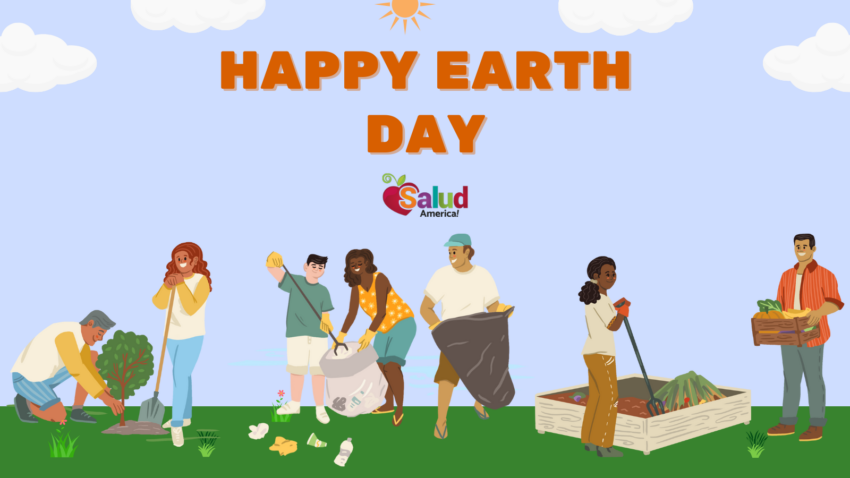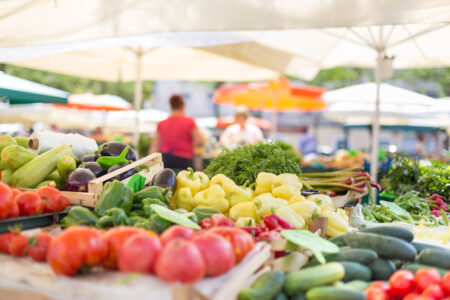
Share On Social!
On April 22, let’s celebrate Earth Day!
Earth Day honors the achievements of the environmental movement and urges for protection of our planet’s natural resources for future generations.
The observance began on April 22, 1970, thanks to Wisconsin Sen. Gaylord Nelson and Harvard University graduate student Denis Hayes. Since then, it has promoted advocacy, education, and conservation around environmental issues like climate change and pollution.
As this year’s celebration approaches, Salud America! is sharing five ways you can get involved to preserve and improve the environment.
1. Reduce, Reuse, Recycle
What is the most effective way to reduce waste? Don’t create it in the first place.
“Making a new product emits greenhouse gases that contribute to climate change and requires a lot of materials and energy – raw materials must be extracted from the earth, and the product must be fabricated then transported to wherever it will be sold,” according to the United States Environmental Protection Agency.
Save energy and money through reducing.
Think green when shopping and consider reusable tote bags rather than plastic or paper. Reduce food waste and consider buying what you need, composting food scraps, and donating unused food to food banks or shelters.
Along with buying used items, when possible, take the time to donate unused clothing, electronics and building materials.
“Not only will you be reducing waste, you’ll be helping others,” according to the EPA. “Local churches, community centers, thrift stores, schools and nonprofit organizations may accept a variety of donated items, including used books, working electronics and unneeded furniture.”
Plastic items such as bottles (with caps), bags, wraps, and other select items can be recycled. However, it’s important to check your local bins to confirm what specific items can be taken.
Other materials such as glass and aluminum can also be recycled. Certain rules also apply when recycling these materials as well. Those interested in recycling glass should ensure there are no broken shards or metal bottle caps. Learn how cities are promoting recycling, too.
“Deciding to recycle items is just the first step. You also want to make sure the items are recycled correctly,” according to the EPA.
2. Gardening
If you’re looking to do something to help the environment while also picking up a new hobby, consider starting a garden.
Gardening can help fight climate change.
“Anyone who gardens in their home or backyard could help contribute to reducing two pounds of carbon emissions for every pound of homegrown vegetables consumed,” according to Salud America! resource.
Whether it’s herbs, flowers, or vegetables, starting a garden can be beneficial in many ways.
The physical process of creating a garden can be a great way to get exercise while also getting your daily dose of sunlight.
While the steps to having a successful garden may seems daunting, there are plenty of resources and tools to help individuals at any gardening level.
Gardening can also be resourceful as, you may be able to donate the food you grow to local food pantries in your area.
You can also help start a community garden in your neighborhood.
Community gardens increase access to healthy foods, improve nutrition and exercise, and improve consumption of fruits and vegetables.
Just ask Jorge Olvera, who started a community garden in Houston.
“[Community gardens] build a sense of community and promote safer neighborhoods,” said Olvera, who also invites school students to learn how to garden.
3. Eating/Buying Local
Many benefits exist for buying and eating locally grown food, including fresher and tastier fruits, vegetables, and more.
“By shopping at farmers markets, you get to find the truest flavors of the season and connect with the growing season where you live,” according to a UMPC article.

Eating locally produced food can also protect the environment.
“Food in the USA travels an average of 1,500 miles to get your plate! This means high use of fuels that pollute the environment,” according to UMPC. “Not only that, many big box farms use pesticides, chemical fertilizers, and processing equipment that can contribute to environmental decay.”
While farmers markets are commonly known for fruits and vegetables, other products like fresh bread, eggs, pastries, and meat among other goods can be found.
Does your town have a farmers market? Find out here.
Farmers markets are a path to healthy food access. They are especially important amid the push for nutrition security and racial/ethnic justice.
“As hubs for connection and community resilience, farmers markets have particularly risen to the occasion this year by providing a necessary sense of unity and stability during a time of great uncertainty,” according to the Farmers Market Coalition. “Farmers markets don’t just happen. The hard work of farmers market operators should be recognized.”
4. Walk or Bike to Destinations
Are you able to walk or bike to your destinations rather than drive?
Take advantage of this opportunity and get your daily exercise while also helping the environment.
“Driving less reduces your carbon footprint. If you’re concerned about reducing carbon emissions, driving less and walking more is good way to lower greenhouse gas emissions,” according to Wheels for Wishes.
Biking is also a great alternative to driving.
“We usually think of gas as the only pollutant when it comes to cars, but they also use antifreeze and other fluids that are bad for the environment. Biking instead of driving cuts down on all of them,” according to a UCLA article.
Biking can also improve both physical and mental health.
“Riding a bike steers your mind away from negative feelings, releasing those feel-good brain chemicals called endorphins which can help keep anxiety and depression away,” according to a UCLA blog. “Exercise such as biking is a top tension-busting strategy, and when done consistently, can decrease stress levels.”
Not every place is bike-friendly, though.
Many cities across the country are designed for vehicles. They are not designed for people walking and biking.
Learn from leaders who are promoting bicycling, like Nathanael Fillmore, who campaigned the first protected bicycle lane law in Cambridge, Mass.
“There was tons of enthusiasm for bike lanes,” Fillmore said.
You can see how your state is promoting bicycling and explore strategies to improve connections between bicycle, pedestrian, and transit infrastructure.
5. Share and Spread Online Messages
Social media can be a powerful tool that others can share information and spread awareness with hundreds and thousands of people.
Make a difference with your smartphone or computer!
Promote Earth Day messages and campaigns from organizations and accounts you follow or create a message of your own.
You can find more information on the official Earth Day website and learn about ways to take civic, community, and individual action, as well as events taking place not only around the nation, but the world.
6. Help Your City Adopt Smoke-Free Multifamily Housing
People who live in multifamily housing share air with their neighbors ─ even secondhand smoke.
Secondhand smoke contains over 70 cancer-causing chemicals, has killed over 2.5 million people, and can travel through doorways, halls, windows, ventilation systems, electrical outlets, and gaps around fixtures.
Download the free Salud America! Action Pack “Help Your City Adopt Smoke-Free Multifamily Housing” to help your city explore a smoke-free multifamily housing policy for common areas and individual units.
Experts say this can protect the health of tenants and staff, as well as save property owners money in unit maintenance, fire prevention, insurance, and reduced legal liability.
You can use model emails, graphics, and policies to explore a local smoke-free multifamily housing policy in your town.
7. Create a Healthier Environment for People to Live
Where you live can have a big impact on your health.
For example, Latinos face health disparities rooted in systemic inequities in access to clinical trials, income, health care, food, housing, and discrimination.
You can help change your community for the better!
Download your own community’s Salud America! Health Equity Report Card to compare local data and maps to your state and nation on a variety of health-related issues like the environment, health care, transportation, access to food, and more.
Share your results with local city representatives, school districts, and social and environmental justice organizations to advocate for change.
By The Numbers
24
percent
of Mexican American-nonsmokers are exposed to secondhand smoke



